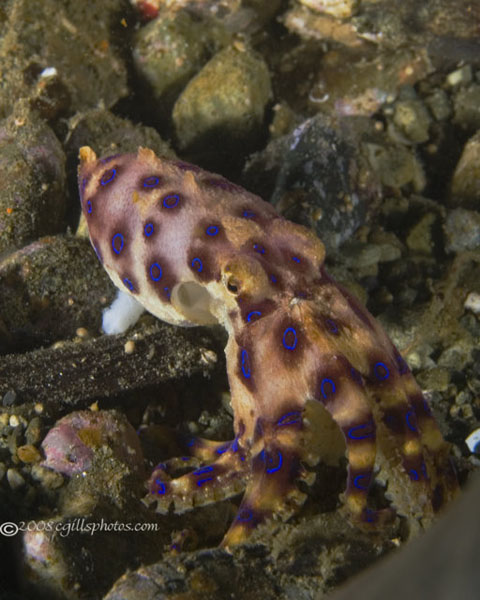
 |
|---|
|
Image © Cindy Abgarian BLUE RING OCTOPUS The Blue Ring Octopus, of which there are several species known, tends to be high on divers’ wish lists for photographs to be gained while diving in Indonesian waters. A rather uncommon octopus species, it is well respected by all, given its highly venomous bite. Two previous trips to Indonesia destinations had found me yet wanting, at the very least, a sighting of this gorgeous, but small (7-10 cm) member of the cephalopod family. Reports of sightings haunted my previous trips, first to Wakatobi, and then to Lembeh, but not knowing how to look, or where, or when, left me hoping for better luck on this adventure. I didn’t realize what was missing from the equation was having Peaches along to help fuel the search. We were night diving in Hila Bay, North Ambon, when the familiar metal-to-metal tapping of the DM's poker on his tank sounded through the water. I could always tell if it was a special find as the tapping would continue, and if you didn’t respond fairly quickly, a DM would come and find you, as was the case with me this time. This find was not to be claimed by the DM, but by Peaches, who with her meticulous scrutiny of the sea bed had found the octopus, and offered to share her discovery. WTG Jamie! Waiting in turn for the opportunity to capture the memory of the venomous cephalopod, divers circled round doing their best to avoid stirring up the slit-covered bottom. Despite all efforts, my attempts that night left me lacking a good photo, but still pleased for the opportunity to finally see one of the region’s Holy Grails. Luckily for me, extending my stay in Ambon after the cruise rewarded me with a second sighting of a BRO, this time near the jetty, and during daylight hours! The DM frantically motioned me over and indicated that something was under the small piece of driftwood he was pointing to. I found myself hating to leave my little frogfish discovery, and remember thinking: this better be good. He lifted the wood gently, with his metal muck stick (used for stabilizing oneself in the muck, signaling divers, parting crinoids etc), and out crawled a very small octopus. It wasn’t until my strobe lit the area around it that the famous blue rings came into view. Right on! Fortunately for me, this interlude went a bit better than my previous opportunity, and I finally captured some photos I am proud of. Tip: To those searching for this elusive little octopus, on return to the States I discovered, while researching the books, that it is not uncommon to find these critters in shallow water near or under jetties, during daylight hours. Good Luck.
|
|---|